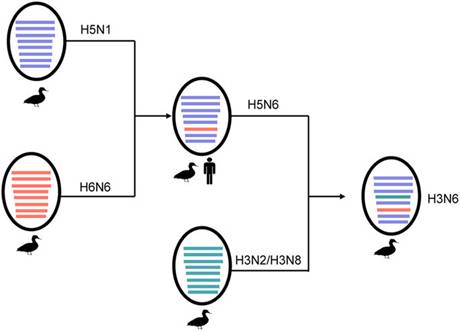Scientist in WIV achieves a progress in study on reassortment of influenza viruses
Date:02-06-2016 | 【Print】 【close】
Multiple infections of avian influenza viruses (AIVs) in poultry or wild birds contribute to the continued evolution of H5 subtype viruses in nature and provide potential recombination of AIVs of different origins. In this study, by collaboration with Prof. Qiyun Zhu in Lanzhou Veterinary Research Institute, Chinese Academy of Agricultural Sciences and Prof. Hualan Chen in Harbin Veterinary Research Institute, the Chinese Academy of Agricultural Sciences, Prof. Jie Cui in WIV, carried out surveillance of AIVs in ducks, geese and the environment of a community in Hunan province, China, from 2014–2015.
They isolated multiple co-circulated AIVs including H3N2, H3N8, and H5N6, and, most importantly, a novel reassortant: H3N6. Phylogenetic analyses suggest that H3N6 is highly likely derived from H5N6, which has recently been shown to have zoonotic potential with human infections. Studies with mammalian cell lines and a mouse model indicate that four selected AIVs of duck or goose origin can infect MDCK and A549 cells but have low pathogenicity in mice. They propose that a potential co-circulation of multiple subtypes including H5N6 in local area may result in the production of novel subtypes such as H3N6 by gene reassortment.
In summary, their study demonstrates that domestic duck and goose farms in southern China provide an ecosystem for co-circulation of multiple AIVs and facilitate the generation of novel reassortants such as H3N6 that could potentially infect mammals. Thus, large-scale surveillance of related AIVs in waterfowl in farms and mammals in surrounding areas are urgently needed in southern China.

Possible genesis of the novel H3N6 reassortant.